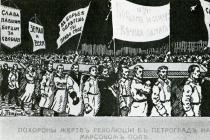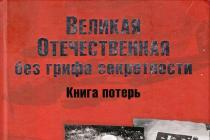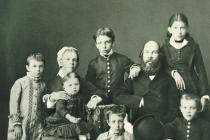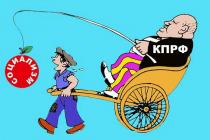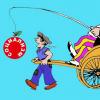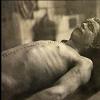Part one. Traditional rag doll of Russian north
Ragdoll
Traditional rag doll, at first glance - the simplest image of a female figure. There is nothing superfluous in it, it is almost a symbol. The basis of the doll is a piece of fabric, rolled into the rolling pin, chest from tightly stuffed balls, braid, motley outfit. But this simplicity is in itself deep meaning.
For a long time, researchers did not guess to look inside the rag doll, where, as it turned out, and hidden the most important secrets.
Russian rag doll includes several archetypes formed by tradition:
the column (column, full, chock),

column (column, full, chock)

crustry or crescents

doll on a stick

node (novel doll)

pelenca

spin (twist, rolling, roller)

printed doll - Pouch
They all existed simultaneously in the XIX - the first half of the 20th century in the village and small provincial cities. Each type, in turn, had many options characteristic of this locality. For example, an archaic type of doll on a stick, modest sizes and noble beauty remained in Russian semidst.

and in the south of Russia - the type of stinging bag-shaped major festive, road and bright doll.
![]()
A rag doll with a cruciform face (Ill. From the book Galina and Maria Dyan. "Russian rag doll. Culture, tradition, technology")
Researchers noticed the fact that dolls different regions With all their external difference, the difference is close by the method of manufacturing internal primary source. They noticed the total for dolls of the Potable base of Tulov, which was so tight, which turned out to be a sculpture from a solid material. The tradition of dressing a wooden wand in the Russian north in the Russian north is a manual coupling of dolls with an ancient marked rolled wood sculpture.

It is not by chance and the ash (stuffed ash) doll is shaken by the continued time "Stone Baba". From here, the ethnographers made a conclusion: "Inside the dressed household doll, toys - homemade, hid her base - idol, spirit of ancestor," and she happens "from the general magic defense of Galina and Maria Dyan. Russian rag doll. Culture, traditions, technology. - 2007, Publishing House: "Culture and Traditions", p. 12 See: http://www.knigidain.ru/biblio.
What archaic ideas accumulated in the torso of the rag doll?
1. First-axis each dolls the column. It was done from the village, sticks or tight tissue tissue. A chopper or twisted tube from above was tightly tightened by a white rag. And then already climbed.

This is simultaneously similar to the baby's swaddling and the cake in the saboan of the dead man. And in that, in another case, the sweltering is wearing sacred meaning. Recall how everywhere in Russia, until the middle of the 20th century, the newborns were peelled, they were called "pelleneski".
The child was wrapped in soft diapers, rushed out of the dilapidated shoes, then "drove" with a swivel - a wide long ribbon of canvas.

The people explained the swelling of children with concern about their physical Health: Pellenali, so that the baby "in the cradle did not jerk, calmly lay and slept", "did not scare myself, did not seek," not a humpback, not a curve, not a club "," so that the handles and legs were straight, were not shrieled. " .
It has long forgotten a protective role of this tradition, but she, of course, was present. It is known that the newborn, especially before baptism, was protected in every possible way from evil spirits, the Schalu and the title. A firmly rolling the child in a stationary pelleling, thus hid it, "buried" from the dark forces, cheated unclean. After all, in such a position, he could not move his hands and legs, nor alive, nor dead, lies.
Puppet Tulovo, tightly seen to the head, speaks of communication with the lower world, where the ancestors live. White rolled figurine, storing peace, was an ancient ritual sign of inviolability, non-existence, death. Moreover, they tied up with a doll inseparable thread, often red. The red color in the Russian tradition was once considered the underhole - this is a symbol of life. That is why the traditional doll at first was so conditional and simple that even her arms and legs are absent.

Doll clash
When they began to portray them, they tied individual sticks on the sides of the sides, or they were sewn completely short legs, and the hands were served with the hands of dolls or hollow patchwork tubes.

The body itself retained the primary basis - this is evidenced by a puppet tradition even in the twentieth century. A doll to the likeness of a person was brought very carefully, fearing to break her independent being.
2. With all its ethnographic differences, the doll is everywhere is the mythological formula of the world order, reflecting the very essence of the universal cycle in nature and in a person's life. The simplest three-inclusive figurine, pulled at the place of the neck and the cocked by a single red thread, was built according to the Triune world scheme: the top, middle, lower. The head of dolls is the Heavenly World, Tulovo - the earthly world, legs - the underworld. Crosas dolls also pointed on four sides of the world.

So in the design itself contained a universal number seven - a symbol of the universe. The magic seven lives in our speech today: "Some seven times", "the seventh water on a kiere", "in the seventh heaven" means at the top of bliss, "in paradise".
Remember more proverbs, sayings, winged expressions, fairy tales with a number of seven.
In Russian fairy tales, there are often three brothers (sisters), seven heroes, treasure hidden "for seven seals", "For family castles" ... Finally, the daily word "family" sounds like an ancient spell: "I" - in the center of the Universe, "I" "Must repeat seven times - then there will be a family. This powerful symbolism is encrypted in a doll.
Skit Cross, who tied up his chest, records the place of dolls in the center of the mythological model of the Triune and four-sided universe. And it means that the simplest archetype of the rag doll passed from the generation to the generation by inherited the code of an ancient world order.
3. In many nations, in mythological ideas about the origin of a person, the first androgic nature of the first time is said, i.e. endowed with men women's signs At the same time. In the Russian rag doll, this mythological symbolism was fully reflected.
The female image was leading not only in the ritual, but also in the traditional game doll. He is very close to the folk female image. So in the songs, fairy tales usually aesthetic "white and round face", "spit to belt", "fullness", "High breasts" and a lush outfit.

Vasnetsov V.M. Three princes of the underground kingdom
With a special care in the rag doll, a magnificent chest was worked out. When two tight ball-gubed balls, pulling the puppet chest with a slam cross, cracked to the doll, tightening the puppet chest, the masters did not invest a special point. Guided rather generally accepted concepts about female beauty. However, it is such detail in a rag toy, like a breast, erected into an unshakable canon, is a clear sign that the doll gave rise to the primary ritual consciousness, mythological thinking of our ancestors.
"Busty Girl" - a living example of honoring the female deity of the Mother Earth, maternal start. The perception of a woman as a continuer of the kind, as the goddess of fertility originated in the first historic period of the stone century, the oldest cultural and historical period in the development of humanity, when the basic tools of labor and weapons were mainly made of stone, but also a tree and bone were also used. At the end of the Stone Age, the use of clay dishes spread. . Image of a woman in Paleolithic era meets very often. Scientists called these images "Paleolithic Venus"

But how was the idea of \u200b\u200bmale start expressed in a doll? And whether in the Russian tradition of dolls- men?
Dolls - peasants were not characteristic of traditional toys. They are rather an exception than the rule. Rustic old-timers from different places are equally answering: "The men did not do, was not accepted," "And if they played a wedding, they took a wand instead of the groom" ...

Dolls
This confirms the analysis of the largest collection of folk dolls from the Ethnography Department of the Russian Russian Ethnographic Museum in St. Petersburg, conducted by S.V. Komarov. It found that out of 850 exhibits collected in Russia, starting in 1902, only about 70 exhibits represent male images.
Rag doll - a peasant. Nach The twentieth century (ill. From the book Galina and Maria Dyan. "Russian rag doll. Culture, traditions, technology")
Is the key not here for an answer? Does then explain the self-sufficiency of the doll with all the fullness of her nature? It is known that the doll in the form of a wooden chock was used in Russian tradition in many rites and almost always performed a symbol of fertility. So, for example, at weddings, the newlyweds were given and thrown into the bed Chock or Plenney, dug in a rag. This custom everywhere existed from the Russian population of the Prikamye, fits into the community traditions of the reproduction of the genus.
We see that the traditional doll carries not only female, but also a male start. And about the male symbolism tells us the post-felled phallic primary doll. We already told you that it could be and simply crawled, and a wand covered with a white rag, and a tight twisted fabric. Wooden solid inside soft busty tool - a sign of natural nature, male and female. Such a doll fell into itself a generic force, carried the idea of \u200b\u200bcontinuing the kind. Death gives birth new lifeAnd life continues in the harmonious merger of two natural principles, male and female. Here is the capacious symbolism of the rag doll.
To be continued…
In the middle of the 20th century, almost every family - in the village and in the city - children played with rag dolls. And only since the 1960s, when industrial enterprises began to produce millions of plastic toys, the tradition of making homely dolls is almost faded. However, she did not disappear completely, postponed in popular memory.
Doll - a sign of a person, his game image symbol . In this role, it focuses the time, the history of culture, the history of the country, the people, reflecting their movement and development.
Traditional rag doll
It is she who carries the memory of culture and makes it much brighter, wider and deeper than any other toy (clay or wooden). The conditional human-like figure once performed a magic role, served as a faith. She participated in rites and holidays, in the ritual events of the circle of life of the earth, noting the birth, wedding, care of the ancestors.
The rag doll is a toy with valuable educational qualities that are recognized and cultivated in ethnopedagogic, in practical work with kids. This is a magnificent sample for handicrafts, artistic work and creativity, decorative and applied art and textile design.
This universal toy has a spiritual filling - the attraction of the patchwork doll lies here. Puppet folk keeps the skill and art of their creators, the work of collectors, collectors and scientists. Life is highlighted in the puppet chronicle russian cultureNegotivating folk memory. And everyone who makes rag dolls, it turns out its "patchwork story."
Surprisingly similarity, roll call dolls from different nations. They are united not only the origin (the game dolls arose everywhere from the rituals, came out of the ritual), but also universal ideas and values: continuity in kinship, familyhood and parental care, in the reverence of ancestors.
The man-made toy served for our ancestors a kind of generic ethnic code, which indicated the landmarks of the life path. Considering the old dolls, we note how the chain of hidden symbols appear in them, characteristic of the mythological consciousness of the peasant, for Russian folk culture. therefore inthe manufacture of traditional rag dolls was not accidental - in everything we saw a certain meaning. As a rule, rag dolls were the simplest image of a female figure: a piece of fabric, rolled into the rolling pin, thoroughly covered with white flaxed face, chest from smooth rag balls, braid and mobular or festive peasant outfit from the flap.
Materials for creating dolls
Most often, puppet costumes sewed from the flap purchased fabric - Citz and Satina, Kumacha and Knewkore. They, unlike dominant, until the beginning of the 20th century remained for the village expensive and intended for festive clothing. The remaining trimming kept in the bags, burned to toys. And when masters of dolls, the patchwork was carefully selected. Especially appreciated red rags, they went to the most beautiful dolls. The red color has served as a faithful, symbol of life and productive power of nature.
The rag dolls, stitched from the new flap, specially made a gift to the christening, to the day of the angel, to the holiday, showing relative love and care. In the old days for the holiday of the introduction of the Virgin in the temple, when winter festivities began on the sleigh, small children and birthday days were sent as a gift "Visor" sledges with dolls. Such a duty was lying on mother-in-law and godded mothers. "Homemade" dolls were given to relatives and relatives, bonding generic bonds: this is also one of the evidence of their sacred value.
In the family, for their children, the dolls "Verters" usually from the old rag. And not even by poverty, but according to the ritual of blood proximity. It was believed that it was believed to be a native matter and, embodied in a doll, passed her to the child, becoming a guard. For dolls most often used the aid of women's wares and aprons. It is these parts of the costume, in contact with the Earth and choosing its strength in this way, had the greatest sacred value. It is noteworthy that the lobs for dolls have always praised on a straight thread, and not cut off with scissors. It was believed that such a toy propheted her little mistress the integrity without flaws and damage.
Often, puppet wear accurately passed the features of local costumes. Today it will seem strange that the costume with the doll was not shot. Are our ancestors could not think of such a simple thing? But they did not set themselves such a task: after all, the doll was created as a holistic form. This is an important principle: the doll is not a dummy mannequin, but a self-made image. The costume organically participated in plastic toys. Its cloud was simple and puppetically expressive. The proportions of large-headed dolls, far from nature, made a puppet costume conditional, allegorical. At the same time, the suit always determined the ethnic concrete type in the doll, responded to the realities of the game. The doll in Pink Sarafan could not play the role of an elderly woman, and the doll "Wife" was not allowed to play the role of "bride."
Powerful symbolism of Russian doll
The researchers did not guess a long time to look inside the rag doll, where it turns out, and its most important secrets are hidden.
Russian rag doll includes several archetypes formed by tradition. The column (column, linen, chock), a crustier or a crusher, a doll on a stick, a nodular (nodular) doll, a shine, a twist (twist, rolling rolling pin), a stuffed pouch doll - they all existed simultaneously in the XIX - the first half of the 20th century In the village and small provincial towns. Each type is scattered in turn into a set of local options characteristic of a particular area.
The researchers drew attention to the fact that the dolls of different regions with all their external difference are close to the methods of manufacturing internal primarily. They noticed the common shape of the body for dolls, which was so tight, which was obtained as if the sculpture was made of solid material.
What archaic ideas accumulated in the torso of the rag doll?
With all ethnographic differences, the doll was the mythological formula of the world order, reflecting the very essence of the universal circuit in the nature and life of a person. The simplest three-part figurine, pulled at the place of the neck and the corded, was built according to the Triune World Scheme: Heavenly (Upper), Earth (Middle) and Underground (Lower). Crosas dolls also indicated four directions of light. Thus, in the design itself, they contained a universal number 7 - a symbol of the universe. Note that the daily word "family" sounds like a spell: "I" in the center of the universe, "I" should repeat seven times - then there will be a family. This powerful symbolism is encrypted and in a doll.
The location of the dolls in the center of the mythological model of the Triune and four-sided universe fixed the oblique cross, who tied her chest. And then the simplest archetype of the rag dolls passed from generation to generation by inherited the code of ancient world order, being a transitional bridge between matter and spirit, the doll combined the ideas about being and non-existence, about life and death:
A ripe, tight-twisted base (without hands and feet, without a face) resembled the dead man, ancestor, and an externally doll portrayed a concrete ethnic type, a woman in a folk costume. The postal phallic shape of the rolling doll tells us also about the male symbolism, and the dedicated chest, a vigorously responded with a slashing cross, is a sign of fertility, testifies to the feminine essence. Death gives rise to a new life, and life continues in a harmonious merger of two natural principles, male and female - such a capacious symbolism contains the formula of the simplest rag doll.
Why did she stay faceless for a long time?
Mystical Wheellessness - also one of the ancient secrets of rag doll . It relates it to the ritual figures, most often also faceless. Generic and homely focus, the memory of the ancestors, the thread of personal fate - on these values \u200b\u200b"the white light converged" when the corners of the bright linen rag were associated with a strong node from linen thread, tosing a spherical head. If such vital ideas were "tinted" in the head of the doll, it is quite logical that the person itself lost any meaning.
An image of a face in a doll for a long time was in the peasant environment under the ban. The chance of retained a doll is safe, like packaging. The attachment of this standing symbolism in the puppet tradition has long been forgotten. When the question, why the doll does not have a face, rustic women answered that she simply don't need her that there should be no extra eyes in the house. So, the shameful doll is dangerous for the child. After all, the eyes, nose, mouth, ears, even drawn - still there are gates, through which communication with the cosmic forces, light and dark, kind and evil. Therefore, it is better not to open these gates, it is more reliable to put a taboo on them. A doll without a face is unreleased from household specifics, from a living person. She is blind, dechah and chimney - in itself, in itself. Only in such a "coffin" silence and can be preserved the mystery of the family, family.
At the end of the XIX century, the desire to make a rag doll more believable. The appearance of the doll changed with the change of its function. The conditioned faceless figure lost a magic ritual role, becoming an entertaining toy purchased at the fair.
The rag doll "acquires a person", which becomes the most important element of the puppet appearance. Traditionally, the face of the dolls painted coal from the stove, and it says about the connection of toys with a homemade hearth. We used simple, chemical and colored pencils, ink. But more often embroidered using traditional folk embroidery techniques, where women's faces were denoted by cross-shaped and diamond patterns. Eyes are depicted with crosses or marked with dots. Their "glades" are empty diamonds, "neither crumbs do not see", just as in a folk court "with good girls neither ears nor eye." The mouth, as a rule, embroidered with red threads with dense stitches or traditional cross ("closed on the castle"). Rootics were small: the doll did not bother the "mouth to smoke", was silent, "how the waters in the mouth scored."
With all the diversity of puppet faces, they all go to their rigor and disguise. There is not a single cheerful, laughing doll. This affects the connection of toys with a cult of ancestors, as well as with the welfare of Orthodox female images that were constantly before their eyes.
At first glance, the traditional Russian doll may seem rude to us, but as we saw, the dolls are very diverse and in their appointment, and in their shape, and on decorative execution. At the same time, traditional dolls do not require any complex techniques or tools for manufacture. It is enough to have a few dilapidated rags, my threads and a desire to create. And here we have a new doll, which, although it looks like her "sister", but, nevertheless, it is unique and unique. For each person brings a particle to his toy. Interestingly, the masters dolls are often similar to it. The knowledge of human traits in the Russian rag doll is an integral line.
In the traditional doll, the sacral and gaming orientation are playing at the same time. The chance and the conventionality of the appearance of the appearance of it in antiquity to act as a ritual symbol, to participate in magic spells and mysteries.

Weping dolls
And thanks to the simple artistic - expressive dolls, peasant children in games with her reflected the world of adults with a large prophence. In puppet games they reproduced the most significant events of rustic life: birth and death, wedding, holidays associated with seasonal changes in nature. And these were not only games for pleasure, through a doll, the child mastered the traditions, the necessary elements of adult life, learned the work. And for the girl a doll was also a measure of her skill.

Girls lacencing for weaving patterns. Foto. Twentieth century
Pokrovsky Egor Arsenyevich Pokrovsky Egor Arsenyevich (1834 - 1895) - an outstanding representative of Russian science, a well-known Moscow pediatrician, doctor of medicine, an honorary member of the Imperial Society of Fans of Natural Science, Anthropology and Ethnography, the founder of domestic ethnography of childhood. Thanks to his activities folk doll For the first time became the subject of scientific and public attention in the late 1870s. He took an active part in creating an anthropological exhibition in 1879. And to the section of its exposition "Meeting on the initial physical education", Pokrovsky E.A. Included the diverse "children's material", where the folk doll, predominantly rag among the cradle, children's clothing and toys. At this exhibition, the world of childhood first appeared as a value phenomenon of folk culture. With difficulty Pokrovsky E.A. "Children's games are predominantly Russians" you can get to know today, in 1994 he was reissued. It is not possible to find it on sale, but in large libraries it can be found. In its encyclopedic work, "children's games are predominantly Russian" released in 1887, wrote: "<…> The dolls a lot promote the good direction of the mind and the fantasy of the child, at the same time they contribute to the development of his language, speech, voices, since the children in their games with dolls often remember, sing, and finally, what else is more precious, it becomes little failing, so , from the small years, the development of good family-moral concepts and rules,<…>obviously, dolls deserve complete approval and encouragement. "

Peasant children. Phukon Sloboda. Nach Twentieth century
In the consciousness of our ancestors, the dolls still possessed various magical properties: they could protect a person from evil forces, take on his illness and misfortunes, console in a difficult moment, give advice, promote good crop, health and well-being of the peasant family members.

Family on a festive day. Orlovskaya province, 1911
Dolls - Talismans were carefully kept in the family, passed from generation to generation together with traditional techniques for their manufacture. This transfer was on the female line from the grandmother (mother) to his granddaughter (daughter). The dolls followed the woman through her entire life, often constituting and part of the dowry - the mother gave their maiden dolls to the wedding daughters, so that she retained and handed them to new generations. So through the careful hands of our great-grandmothers, grandmothers and mothers Traditional Russian doll reached the present day.

Pakhomov A.F. Granddaughter hangs
Having done this long way from the original times and to the present day, the image of the traditional doll, inevitably changed. So at the end of the XIX century, men's characters in the puppet world appeared under the influence of the urban toy. Knowledge of people gradually changed, their horizons expanded, the perception of the world was becoming different, and the dolls began to embroider or paint face. She lost her chance.


Dolls from the exhibition "Tolerance" (in the Smolny Exhibition Hall, St. Petersburg, March 2012)
Gradually, leaving the effect of time, the traditional rag doll finally turned into a children's toy. And the time continued its run, and the person developed with him. Along with global discoveries, qualitatively changing the life of mankind in general, people came up with more and more new materials for the manufacture of dolls.

Photo beginning. Twentieth century
At the end of the XIX century, along with handicraft workshops, where dolls and other toys were made, the capital of Russia's toy fishing was finally drawn up - Sergiev Posad. And the Sergiev-Posad masters knew how to hang people! Their "functions" moved, they sounded, hit their diversity and bliss. And although at the end of the XIXVEK, peasant children played in homemade rag dolls, the demand for "real" toys was great. Fathers and mother brought the kids and cavaliers, faders and sailors from the fair of kids.

Doll "Waist", "Cucker" doll, "Matrosik" doll. (Sergiev Posad)
At the same time, a folk toy and including a rag doll actively begin to study historians and ethnographers. Following the works of E.A. Pokrovsky appear studies, detailing the traditional doll and the game with it. In society, this topic has received a wide response - local history museums began to occur throughout the country, teachers and enthusiasts created society of lovers of Russian culture. The efforts of such societies and museums began to form beautiful collections of traditional dolls and toys.

Cart with traditional Russian dolls (private collection)
In the late 20s of the twentieth century, psychologists of the old pre-revolutionary school and representatives of the Soviet professorship during their studies came to the conclusion that the game in the dolls raises the heart and will more than intelligence that in the doll games reflect the whole range of the surrounding life, naturally manifests "Maternity instinct, having enormous social importance." But the new Soviet ideology rejected such an understanding, declaring the doll with a harmful toy, sorrying the interests of the girl, raising the love of "rags", outfits, decorations, thereby fixing the negative skills of the Meshchansky life of Galina and Maria Dyn. Russian rag doll. Culture, traditions, technologies. - M.: Publishing House "Culture and Tradition", 2007, p. 115. Began to persecutes on local history, ethnology, repressions of scientists banning on their works. Museums and societies closed. Under the ban was not only a traditional rag doll, but also folk games, and children's folklore fairy tales.
From the point of view of a new ideology, the doll was supposed to be ideological in content and realistic in shape.



Dolls of the Minsk Association "World" (photos from Belkukla.by)
But, nevertheless, the Soviet toy of the new sample was necessary for something to rely on his formation. In the 1930s, large expeditions were organized, engaged in the study of traditional toys of national minorities.

Figures from the "15 Union republics" set.
Against the background of a fairly extensive panorama of the peoples of the USSR, the Russian folk doll occupied more than a modest place. She was devoted to the work of ethnographer I.M. Levina, written on the materials of expeditions to the northern regions of Russia in the 1920s. This study has become unique for many years.
For in the future, neither Soviet ethnography nor Soviet art history did not consider a rag doll as a serious subject for research. A stamp was put on it - "It does not represent artistic value." Therefore, the traditional dolls gathered in the repositories of local history museums at the beginning of the twentieth century. As a result of such an inattention, the rag doll by the 1970s completely disappeared from the children's life.

Soviet dolls. 1968.
And it is not known how long this oblivion would have lasted if it were not for enthusiasm and interest in the folk toy of Galina Lviv Dyan Galina Lvovna Dyane (1941 -) - a candidate of art history, a recognized specialist in the field of studying Russian toys and children's culture, author about 250 publications. Dyn's work is valuable scientific and practical importance, used in schools and university curricula, in classrooms in the houses of people's creativity, aesthetic centers and clubs, art schools, in the circles of folk directions and Orthodox gymnasiums. . She contributed to the revival and study of the traditional rag doll in Russia. In the 1970s, G.L. Din organized its first expedition on the Yaroslavl region, in order to study Russian rag doll. Since then, she does not stop their searches and research, infecting people around themselves and through their books is as sincere love, genuine interest and respect for puppet masters and their works.

G.L. Dyn with his reader Elena Elagina (taken from the sitehttp://oldtoysfactory.blogspot.com)
In the history of Russian art cultivation G.L. Dina has become the first researcher of traditional dolls from textiles. And each of her work in this area illuminates new aspects and meanings of the traditional rag doll. Works in town Dane works with works by G.L. Dyan can be found here http://www.knigidain.ru/biblio, dedicated to the traditional Russian doll and toy, today are the most comprehensive and solid studies of this subject. They do not have a place for speculation and fantasies, in all their conclusions G.L. Dyain relies on materials collected in numerous ethnographic sources and expeditions.


Illustrations from Galina and Maria Dyn. Russian rag doll Culture, Tradition, Technology
It is G.L. Din first formulated the thesis on the widespread prevalence of the rag doll in the children's divorce of the Russian village of the XIX-early XX century, demonstrating the artistic content and shape of the rag doll with its functions, revealed the root cause of the seriousness of the traditional doll and revealed the connection of the thoroughly marked chest in the doll with honing the Great Mother (Women Divine).

Faceless rag doll Nach.Hh century, Smolensk province(Ill. From the book of Galina and Maria Dyan. Russian rag doll. Culture, traditions, technology)
Thanks to the work of G.L. Dien Roga Doll was returned the status of a full-fledged work of folk art. And it is especially important that the doll returned to life in the Russian cultural tradition. Art historians and part-time employees of the museum of toys in Sergiev Posade V. Soloviev, G. Dyan, T. Transovseva, I. Schubenkina, M. Dyan, S. Pankov, A. Kulyukina, created in the late 1980s Center Sergiev Traditional culture. Where they themselves with enthusiasm began to twist the rag dolls, study the technologies of its manufacture.

Master Class " Textile doll"From Artists Sergiyev Posada Mary and Elena Dmitriev (Oct. 2011, Kamyshin).
Their undertaking caused public resonance. In the post-Soviet 1990-20s, practical interest in the study of the rag doll was very active, spreading through the cities of various regions and regions of Russia. Clubs, clubs, studios on the basis of museums, houses of folk, children's and youth creativity began to open. Knowledge of traditions and skill of making dolls are now in demand now as never before.

According to observations of G.L. More than 150 craftsmen in Moscow and St. Petersburg, in Arkhangelsk, Petrazavodsk and Kirov, in Izhevsk and Saransk, in Ryazan, in Izhevsk and Saransk, in Ryazan, Cherepovets, Uglich and Yaroslavl, in Nizhny Novgorod, Yekaterinburg and Lipetsk, Chelyabinsk and Irkutsk, in Moscow region Sergiev Posad, Khotkov, Mytishchi, Pushkin, Lytkarina.
Creative puppeteer luggage contains over 100 basic types of dolls and about 200 different variations. Cubany find contacts and works of Rimma Tarasova here http://kuklakaluga.narod.ru/ try to identify regional features of local dolls, use genuine fabrics and finishes, display ethnographic suit Site N.V. Dogaeva, dedicated to the folk toy and masters of a puppet case, see the ourselves http://www.rukukla.ru/.
For independent work to the topic Traditional doll in the cycle of times and events
Modern children are sometimes difficult to surprise some simple toy. But the bunny of the bunny on his finger is always delighted with the children's audience. I suggest you make it.
Although the classic folk toy is made from old cotton fabrics, I suggest you take the fleece. From this material, it is raised by plush and fluffy. For the manufacture of a bunny on your finger, we need: segment of the fabric (10 x 20 cm), threads, fabric trimming / wool / sintepon

1. Crawle upper top corner down

2. And then raise this corner up.

3. At the top we had 2 corrodes. It will be the ears of our bunny. We tie them with a thread.
![]()


4. As a rule, in the folk toy did not make nodules, but fixed the rope with the help of a loop. Let's try to do as well. After fixing, we do not break the thread, but, as in the case of an angel, try to make a bunny continuous thread.

5. Then we take a small rome of climbing fabric or wool to foggle.


6. Till the head all the same thread, after passing it under the cloth.

7. Now we turn the bottom of the fabric into the roll and raise it to the head

8. From the edges of the fabric we form legs and tie them all the same thread, fastening the loop



![]()
Bunny on my finger ready!

For the manufacture of a bunny, we needed quite a bit. In Russian tradition, there are dolls even simpler in its manufacture. It is a cumulus doll and a doll on a spoon. Try to make them watching video.


